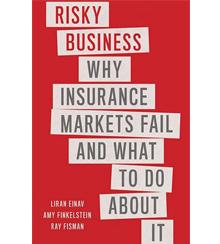Simplifying the complexities of insurance markets
| 11:26 (há 54 minutos) |   | ||
| ||||
|
A closer look at insurance markets
A new book offers a primer on the complexities that underpin the age-old insurance industry.

Risky Business: Why Insurance Markets Fail and What to Do About It
by Liran Einav, Amy Finkelstein, and Ray Fisman, Yale University Press, 2023
What’s going on with insurance markets? Why are policies so expensive and riddled with exemptions? Why do insurance companies have a bad rap when it comes to making claims? These are frustrating questions because the principle behind insurance is straightforward and the benefits are obvious: occasionally in life, something unlikely but potentially ruinous occurs. Because no one can be expected to live life to its fullest and remain prepared for every possible eventuality, insurance policies spread the risk around a large group of people.
According to Risky Business, a gem of a book by three academics, Liran Einav, Amy Finkelstein, and Ray Fisman, there is a very simple reason why insurance is so infuriating. At its heart, insurance is all about what economists call selection markets. Insurance markets are selection markets because not all customers are equal: insurers want customers who pay their premiums and rarely file claims, and they don’t want customers who regularly draw on their policies for expensive work. Customers, meanwhile, want to choose from a range of policies at reasonable prices.
The authors’ first example of the problems faced by selection markets is also their best. In 1981, American Airlines offered its customers free first-class travel for life in exchange for an up-front lump sum. The airline assumed the offer would attract business travelers. It never occurred to the company that some people really like to fly for fun. Servicing these leisure travelers proved very expensive because of the frequency of their travel, so American raised the price of the plan. After several more rounds of price hikes, the company withdrew the offer for good in 1994. “American learned the hard way that the customers who are willing to pay the most are sometimes the ones you want the least,” the authors explain. The selection market had collapsed.
Keeping selection markets afloat proves to be a stubborn problem. The key is information. Customers know things about themselves—such as a love of luxury flying, aspects of their medical history, or their confidence as a driver—that would affect the insurer’s willingness to sign them up. And customers will always seek to get the most out of their policies. The authors highlight research from a health economist, Marika Cabral, which showed that when customers of a dental plan offered by a private firm were offered the chance to upgrade to a new plan with a higher benefit ceiling, the value of claims jumped by 60% in the month following the switch.
Insurers have tried a few different strategies to mitigate the disadvantage of asymmetrical information. Among them are introducing holes into the coverage. Life and car insurance policies will often include waiting periods to prevent customers from signing up only to make an immediate claim. Or there will be more subtle nudges to encourage the “right” customers to join, such as health insurers offering discounted gym memberships. Fascinatingly, one study of life insurance customers found that those who enrolled and were offered access to a wellness program did not benefit, from a health perspective, over those who did not participate; they were already fitter to begin with.
One study of life insurance customers found that those who enrolled and were offered access to a wellness program did not benefit, from a health perspective, over those who did not participate; they were already fitter to begin with.
Even when the amount of information available to insurers increases (and insurers have become much more sophisticated at gathering and analyzing data than they used to be), customers still seem to have a better sense of their own future. Another study cited by the authors compared two sets of older adults who were comparable across every category that life insurers care about, including health status and preferred hobbies. During the 12 years of the study, those participants who died were 20% more likely to have bought life insurance. This is where the issue becomes inexplicable. The authors admit they are baffled as to what information “people are able to keep to themselves that is both relevant to their survival prospects and isn’t on the application.”
But—and this is what makes selection markets so puzzling—the authors argue convincingly that customers shouldn’t be striving for the complete sharing of information, either. Although insurers are desperate to know as much about their potential customers as they can, they often refrain from asking questions that they are legally allowed to ask. If insurers knew that a customer came from a family with a history of chronic disease, they could opt against insuring them altogether. Or, as the authors put it, perfect information would “destroy people’s ability to buy insurance against being (or becoming) a bad risk,” which is entirely the point of being able to be insured in the first place.
In an excellent section, the authors refer to a New York Times article from 2020 that uses one particular case to rail against Medicare Advantage, the system that offers subsidies for private insurance for elderly Americans. At 65, a healthy man enrolled in a “light” policy with low premiums. Seven years later, he was diagnosed with cancer, treatment for which was not covered by his policy. He found he couldn’t switch policies, a decision the newspaper criticizes. Reading the article, it is easy to feel the customer has been treated unfairly. But to the authors, his case reveals a common misconception about insurance, which “you’re supposed to buy…in order to insure against a possible event or risk, not to pay for that eventuality after it happens.” It takes some courage to argue that an ill, elderly man should not be entitled to more comprehensive healthcare, and it also takes skill to avoid coming across as cold-hearted, dismal scientists while doing so, but these authors manage it. As a primer on how a seemingly simple industry is actually infernally complicated, Risky Business is a superb read.
Author profile:
- Mike Jakeman is a freelance journalist and has previously worked for PwC and the Economist Intelligence Unit.




No comments:
Post a Comment